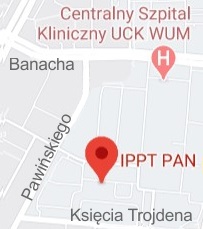| 1. |
Błachowski B., Świercz A., Ostrowski M., Tauzowski P., Jankowski Ł., Computationally efficient optimal sensor placement,
DSA 2024, Dynamical Systems and Applications VI, 2024-06-26/06-28, Łódź (PL), pp.1-1, 2024 Streszczenie:
The topic of smart civil infrastructure has attracted significant attention. An important component of such structural systems is the network of sensors used to monitor the structure and deliver information about its current health status. The task of optimal sensor placement is not trivial due to the discrete, combinatorial nature of the problem. The brute force search is unfeasible for large structures, which calls for approximate and heuristic approaches. This problem has been investigated for several decades, beginning probably with the landmark 1978 paper of Shah [1]. A recent review can be found in [2].
The criteria typically used for assessing candidate placements are based either on Kammer’s Effective Independence (EFI) and the Fisher Information Matrix (FIM) [3], and quantify the amount of information provided by sensors, or on covariance matrices obtained within the Kalman filtering procedure used to quantify the uncertainty of the unknown response of interest being estimated [4]. However ingenious, most of the proposed procedures are computationally costly in large-scale problems.
This talk will discuss two optimal placement methods that have been recently developed with the objective of computational efficiency [5, 6]. One of them is based on Kalman filter covariance matrices and has—instead of typically quadratic—a linear complexity in the number of potential sensor locations. The other method uses the technique of convex relaxation to represent the problem in a computationally tractable continuous form and speed up the solution procedure even further. The presented application examples will use models of bridge structures.
[1] P.C. Shah, F.E. Udwadia, A methodology for optimal sensor locations for identification of dynamic systems, J. Appl. Mech. 45(1), 188–196 (1978)
[2] Y. Tan, L. Zhang, Computational methodologies for optimal sensor placement in structural health monitoring: A review, Struct. Health Monit. 19(4), 1287–1308 (2020)
[3] D.C. Kammer, Sensor placement for on-orbit modal identification and correlation of large space structures, J. Guid. Control Dyn. 14(2), 251–259 (1991)
[4] C. Zhang, Y.-L. Xu, Optimal multi-type sensor placement for response and excitation reconstruction, J. Sound Vib. 360, 112–128 (2016)
[5] B. Błachowski, A. Świercz A., M. Ostrowski, P. Tauzowski, P. Olaszek, L. Jankowski, Convex relaxation for efficient sensor layout optimization in large-scale structures subjected to moving loads, Comput.-Aided Civ. Inf. 35(10), 1085–1100 (2020)
[6] B. Błachowski, A. Świercz, P. Olaszek, Ł. Jankowski, Implementation of multi-type sensor placement strategy for large-scale engineering structures, 10th ECCOMAS Thematic Conference on Smart Structures and Materials (SMART 2023), July 3–5, 2023, Patras, Greece, pp. 498–506 (2023) Afiliacje autorów:
| Błachowski B. | - | IPPT PAN | | Świercz A. | - | IPPT PAN | | Ostrowski M. | - | IPPT PAN | | Tauzowski P. | - | IPPT PAN | | Jankowski Ł. | - | IPPT PAN |
|  |
| 2. |
Błachowski B., Tauzowski P., Automating Structural Health Assessment: A Machine Learning Approach for Identifying Concrete Defects,
22nd International Conference - Modelling in Mechanics 2024, 2024-05-23/05-24, Karlov pod Pradedem (CZ), pp.1-1, 2024 |  |
| 3. |
Błachowski B., Tauzowski P., Zawidzka E., Zawidzki M., Jankowski Ł., Topology optimization of hyper-redundant modular robotic manipulator,
SolMech 2024, 43rd Solid Mechanics Conference, 2024-09-16/09-18, Wrocław (PL), pp.258-258, 2024 Streszczenie:
This study deals with topology optimization of spatial robotic manipulator, the geometry of which was
proposed initially in [1]. The manipulator consists of serially connected modules in a form of a
cylinder cut at a certain angle at its ends. The manipulator constructed in this way allows for relative
rotation of adjacent modules, which gives one degree of freedom per module. The operation of overall
robotic system resembles the elephant trunk manipulator. Previous research involved the possible
kinematic transformations of the manipulator [2], but not its structural optimization [3]. However,
structural design of the involved modules is a challenging task, as the process has to take into account
the current configuration of the module along the manipulator, which results in variable internal force.
It leads to optimization problem under multiple loading conditions with a significantly large number of
loads. This study considers optimal topology of such a modular manipulator structure. Due to the large
variety of possible load conditions, the initial analysis involves a 3D model of the structure with a
continuous set of possible arrangements of individual modules. An additional constraint imposed on
the solution will take into account the symmetry of the optimal topology of a single module, which is
dictated by manufacturing considerations. Słowa kluczowe:
optimal topology, modular systems, engineering software Afiliacje autorów:
| Błachowski B. | - | IPPT PAN | | Tauzowski P. | - | IPPT PAN | | Zawidzka E. | - | IPPT PAN | | Zawidzki M. | - | IPPT PAN | | Jankowski Ł. | - | IPPT PAN |
|  |
| 4. |
Błachowski B., Tauzowski P., V4SHM - Visegrad Project on Autonomous Systems for Structural Health Monitoring,
Modelling in Mechanics 2022, 2022-05-26/05-27, Rožnov pod Radhoštěm (CZ), pp.1-1, 2022 Streszczenie:
The goal of the project is the development of methodology for reliable identification of different structural defects, including concrete cracks, spalling and delamination. The basic idea of this project combines machine learning and image processing techniques to localize and quantify stiffness degradation with concrete structures. The overall system is intended to operate in fully autonomous way. it is allowed by recent advancement in image capturing utilizing the unmanned ground or aerial vehicles and artificial intelligence. Słowa kluczowe:
structural health monitoring, computer vision, crack detection Afiliacje autorów:
| Błachowski B. | - | IPPT PAN | | Tauzowski P. | - | IPPT PAN |
|  |
| 5. |
Tauzowski P., Jarosik P., Żarski M.♦, Wójcik B.♦, Ostrowski M., Blachowski B.♦, Jankowski Ł., Computer vision-based inspections of civil infrastructure,
Modelling in Mechanics 2022, 2022-05-26/05-27, Rožnov pod Radhoštěm (CZ), pp.1-7, 2022 Streszczenie:
The uNET neural network architecture has shown very promising results when applied to semantic segmentation of biomedical images. The aim of this work is to check whether this architecture is equally applicable to semantic segmentation distinguishing the structural elements of railway viaducts. Artificial images generated by a computer graphics program rendering the 3D model of the viaduct in a photorealistic manner will be used as data sets. This approach produces a large number of
images that provide a solid training set for machine learning model. Słowa kluczowe:
Computer vision, deep learning, semantic segmentation Afiliacje autorów:
| Tauzowski P. | - | IPPT PAN | | Jarosik P. | - | IPPT PAN | | Żarski M. | - | Institute of Theoretical and Applied Informatics, Polish Academy of Sciences (PL) | | Wójcik B. | - | Institute of Theoretical and Applied Informatics, Polish Academy of Sciences (PL) | | Ostrowski M. | - | IPPT PAN | | Blachowski B. | - | inna afiliacja | | Jankowski Ł. | - | IPPT PAN |
|  |
| 6. |
Błachowski B., Tauzowski P., Lógó J.♦, Stress-constrained approach for optimal design of structural topology,
BSD2022, International Conference of Selected Issues In Building Structures Design, 2022-07-14/07-15, Kielce-Cedzyna (PL), pp.94-95, 2022 Streszczenie:
The aim of the paper is a practical engineering formulation of the topology optimization for
structures made of elastoplastic material. This paper provides a comprehensive approach to
optimizing the topology of elastoplastic structures, including both the problem statement and its
efficient computer implementation. Instead of the traditional compliance minimization approach,
the aim of this work is to find a structure with the minimum mass that can carry on a given load,
provided that the corresponding stresses do not exceed an acceptable limit. The general formulation
of the problem is based on the classical approach allowing to determine the yield strength of the
designed structure [4]. The proposed method finds the optimal structure in an iterative way, using
only the stress intensity distribution and does not require the user to explicitly know sensitivity. Słowa kluczowe:
topology optimization, stress constraints, optimal design Afiliacje autorów:
| Błachowski B. | - | IPPT PAN | | Tauzowski P. | - | IPPT PAN | | Lógó J. | - | University of Technology and Economics (HU) |
|  |
| 7. |
Tauzowski P., Błachowski B., Lógó J.♦, An efficient method for topology optimization with prescribed safety margin,
CMM-SolMech 2022, 24th International Conference on Computer Methods in Mechanics; 42nd Solid Mechanics Conference, 2022-09-05/09-08, Świnoujście (PL), No.ID 247, pp.1-1, 2022 Streszczenie:
To solve the problem of reliability-based topological optimization, a heuristic algorithm was used, consisting in removing redundant material in the areas with the lowest stress intensity. In this algorithm, the design variables represent the material densities in the individual finite elements. The material is removed by reducing the density of finite elements as a function of the stress intensity. Słowa kluczowe:
topology optimization, reliability analysis, first order approximation Afiliacje autorów:
| Tauzowski P. | - | IPPT PAN | | Błachowski B. | - | IPPT PAN | | Lógó J. | - | University of Technology and Economics (HU) |
|  |
| 8. |
Zawidzka E., Tauzowski P., Zawidzki M.♦, Błachowski B., Jankowski Ł., Structural topology optimization of a modular snake-like manipulator,
CMM-SolMech 2022, 24th International Conference on Computer Methods in Mechanics; 42nd Solid Mechanics Conference, 2022-09-05/09-08, Świnoujście (PL), pp.1-1, 2022 Streszczenie:
This contribution concerns a snake-like robotic manipulator arm proposed first in [1]. The manipulator is composed of linearly but nonaxially joined identical modules with a possibility of relative twist, which amounts to one degree of freedom per module. It is an example of an extremely modular system [2], and its advantages are: economization (due to modularity and possible mass production) and robustness (easy repair by replacement of a failed module). The hitherto research involved the possible geometric transformations of the manipulator arm [3], but not its structural optimization. However, structural design of the involved modules is a challenging task, as the process has to take into account the relative position of the module along the arm, as well as the variety of global configurations of the deployed manipulator. It leads to a multi-load structural optimization problem with a significantly large number of loads. This contribution considers topology optimization of such a modular manipulator structure. Due to the large variety of possible load conditions, the initial analysis involves a 2D model of the structure with a discrete set of two possible relative arrangements of adjacent modules. Such a formulation allows the proposed approach to be preliminarily explored, tested and optimized in a numerically manageable simplified environment. The support of the National Science Centre, Poland, granted under the grant agreement 2019/33/B/ST8/02791 is gratefully acknowledged. Afiliacje autorów:
| Zawidzka E. | - | IPPT PAN | | Tauzowski P. | - | IPPT PAN | | Zawidzki M. | - | inna afiliacja | | Błachowski B. | - | IPPT PAN | | Jankowski Ł. | - | IPPT PAN |
|  |
| 9. |
Ostrowski M., Błachowski B., Żarski M.♦, Wójcik B.♦, Tauzowski P., Jankowski Ł., Comparison of the accuracy of computer vision-based methods for estimation of structural displacements using synthetic video data,
EACS 2022, 7th European Conference on Structural Control, 2022-07-10/07-13, Warszawa (PL), pp.66-67, 2022 Streszczenie:
Despite significant advances in structural health monitoring (SHM), the design of contact sensor networks and their power supply for large-scale structures is still expensive and difficult. Due to the recent progress in computer vision (CV) it is possible to monitor structural components or even whole structures with the aid of digital cameras that allow to avoid the use of the contact sensors. However, CV-based measurements have a significantly lower accuracy than the techniques based on the contact sensors. Moreover, the amount of benchmark data available for development, testing and comparison of CV-based methods is limited. This problem has been partially overcome in recent years by the use of the physics-based graphical models (PBGM) in generation of synthetic but realistic video data. In this work, a comparison of two popular methods of CV-based object tracking applicable in SHM is discussed. PBGM-based videos used in this study are a part of The 2nd International Competition for Structural Health Monitoring'. Exact structural displacements are available due to the fact that PBGM-based video are generated using the structural model. Hence, calculation of the error metrics is straightforward and reliable. The PBGM-based videos show a spatial truss subjected to an unknown excitation. Afiliacje autorów:
| Ostrowski M. | - | IPPT PAN | | Błachowski B. | - | IPPT PAN | | Żarski M. | - | Institute of Theoretical and Applied Informatics, Polish Academy of Sciences (PL) | | Wójcik B. | - | Institute of Theoretical and Applied Informatics, Polish Academy of Sciences (PL) | | Tauzowski P. | - | IPPT PAN | | Jankowski Ł. | - | IPPT PAN |
|  |
| 10. |
Ostrowski M., Błachowski B., Żarski M.♦, Wójcik B.♦, Tauzowski P., Jankowski Ł., Computer vision-based vibration measurement,
Modelling in Mechanics 2022, 2022-05-26/05-27, Rožnov pod Radhoštěm (CZ), pp.1-6, 2022 Streszczenie:
In the present study a benchmark test of selected methods of template matching-bated methods for computer vision-based object tracking is performed. The attention is paid to compare these methods in terms of estimation of nodal displacements in a flexible truss structure, aiming at assessment of their reliability in Structural Health Monitoring (SHM) applications. Thanks to the use of synthetic but realistic videos generated with the aid of physics-based graphics models (PBGM), exact displacement of tracked structural nodes are known. Therefore, reliable assessment of the accuracy of the examined methods is possible. Słowa kluczowe:
computer vision, structural health monitoring, physics-based graphics models (PBGM) Afiliacje autorów:
| Ostrowski M. | - | IPPT PAN | | Błachowski B. | - | IPPT PAN | | Żarski M. | - | Institute of Theoretical and Applied Informatics, Polish Academy of Sciences (PL) | | Wójcik B. | - | Institute of Theoretical and Applied Informatics, Polish Academy of Sciences (PL) | | Tauzowski P. | - | IPPT PAN | | Jankowski Ł. | - | IPPT PAN |
|  |
| 11. |
Ostrowski M., Błachowski B., Świercz A., Tauzowski P., Olaszek P.♦, Jankowski Ł., Efficient Method for Optimal Sensor Placement in Large-scale Structures,
CIMTEC 2022, 15th International Conference on Modern Materials and Technologies - 9th Forum on New Materials, 2022-06-25/06-29, Perugia (IT), pp.1, 2022 Streszczenie:
In practice, the broadly used finite element (FE) models can have very large number of degrees of freedom (DOFs). A small subset of DOFs representing sensor locations that provides an extremum of a selected objective function corresponding to a metric of the expected measurement accuracy is sought. Thus, optimal sensor placement is characterized by its complex combinatorial nature and tremendous computational effort required. With the aid of convex relaxation, the proposed approach allows one to transform the original combinatorial problem into its continuous counterpart, which requires smaller computational effort – by a few orders of magnitude than famous Effective Independence method. The effectiveness of the method has been demonstrated using an example of a FE model of an existing railway bridge. First, the FE model has been calibrated with measured responses of the bridge under the moving load of a passing train. Then, sensor layout has been obtained in such a way that it optimises the estimate of modal coordinates of the mode shapes participating most significantly in the measured structural response. The authors acknowledge the support of the National Science Centre, Poland (grant agreement 2018/31/B/ST8/03152). Afiliacje autorów:
| Ostrowski M. | - | IPPT PAN | | Błachowski B. | - | IPPT PAN | | Świercz A. | - | IPPT PAN | | Tauzowski P. | - | IPPT PAN | | Olaszek P. | - | Instytut Badawczy Dróg i Mostów (PL) | | Jankowski Ł. | - | IPPT PAN |
|  |
| 12. |
Lógó J.♦, Tauzowski P., Blachowski B., Ismail H.♦, Reliability-based approches for topology optimization of elastoplastic structures,
ICTAM, 25th International Congress of Theoretical and Applied Mechanics (ICTAM 2020+1), 2021-08-22/08-27, Milan (IT), No.O106110 - FS10, pp.2911-2912, 2021 Streszczenie:
Plasticity in topology optimization is almost forgotten direction in this popular research area. This paper presents a recently
developed elasto-plastic topology optimization procedure extended with reliability constraint. It recalls fundamental concepts from
reliability analysis and introduces an algorithm for topology optimization of elasto-plastic structures. In addition to the elasto-plastic
constitutive law of the applied material the optimization algorithm includes stress constraints, as well. The presented numerical examples
show dependence of the volume fraction on probability of failure. Afiliacje autorów:
| Lógó J. | - | University of Technology and Economics (HU) | | Tauzowski P. | - | IPPT PAN | | Blachowski B. | - | IPPT PAN | | Ismail H. | - | inna afiliacja |
|  |
| 13. |
Zabojszcza P.♦, Radoń U.♦, Tauzowski P., Optimization of a steel structure taking into account the randomness of design parameters,
WEO 2021, 2nd Workshop on Engineering Optimization, 2021-10-07/10-08, Warszawa (PL), pp.70, 2021 |  |
| 14. |
Tauzowski P., Błachowski B., Logo J.♦, First-order reliability approach for fatigue resistant topology optimization of elastoplastic structures,
WCSMO, 14th World Congress of Structural and Multidisciplinary Optimization, 2021-06-13/06-18, Boulder, Colorado (US), No.207, pp.1-2, 2021 |  |
| 15. |
Tauzowski P., Błachowski B., Logo J.♦, First-order approach for structural topology optimization with low-cycle fatigue constraints,
LSCE, XXVII Conference of Lightweight Structures in Civil Engineering, 2021-12-02/12-03, Łódź (PL), pp.1-4, 2021 Streszczenie:
In the present study topology optimization with constraints on the probability of failure is presented. The proposed approach allows controlling the safety level during the optimization process. The number of cycles to structural failure in the case of low-cycle fatigue problem is chosen as a constraint. The low-cycle fatigue requires elastic-plastic formulation of the problem, because in the optimized structure the phenomenon related to accumulation of plastic deformation is observed. In order to estimate the probability of failure for this numerically complex problem, the First Order Reliability Method (FORM) is proposed. The above mentioned methodology is implemented in object-oriented code written in MATLAB programming language. Słowa kluczowe:
topology optimization, reliability analysis, low-cycle fatigue, object oriented programming Afiliacje autorów:
| Tauzowski P. | - | IPPT PAN | | Błachowski B. | - | IPPT PAN | | Logo J. | - | inna afiliacja |
|  |
| 16. |
Logo J.♦, Tauzowski P., Błachowski B., Topology optimization of elastoplastic structures under reliability constraints: A first order approach,
CIVIL-COMP-OPTI 2019, Fifth International Conference on Soft Computing & Optimisation in Civil, Structural and Environmental Engineering, 2019-09-16/09-19, Riva del Garda (IT), pp.1-3, 2019 Streszczenie:
Structural safety is a critical aspect in modern engineering practice. One of the factors leading to the risk of failure is the variability of design parameters. To be able to estimate the risk of failure, this variability should be taken into account in design process. One way to tackle this issue is to assume a random nature of selected design parameters. These parameters can represent: loads acting on a structure, material properties or shape parameters. Minimizing the structural mass in the process of topology optimization is equivalent to removing the material from the initial, usually regular design space. This process can lead also to a reduction of the structural safety. Therefore, apart from deterministic constraints (such as stresses, displacements or load capacity), it is also worth to control the probabilistic ones. The purpose of this work is to introduce in topology optimization of elastoplastic structures an additional constraint on the probability of failure. Deterministic constraints, in the form of constraints on stresses, are imposed on elastoplastic analysis and utilized by the return mapping algorithm. One of the difficulties coming from the application of these random effects in the process topology optimization is its numerical complexity. Topological optimization itself is a complex issue. Adding a structural safety estimation can extend this process significantly. Fortunately, in the field of reliability analysis, which deals with determining reliability, there are methods that allow for relatively fast estimation of the probability of failure. These are First and Second Order Reliability Methods (FORM, SORM). Only several finite element iterations are sufficient to determine the probability of failure. These methods are based on the concept of the design point or the most probable point. This is the point on the limit state surface that lies closest to the mean point, and represents the most probable failure scenario. Moreover, approximation of limit state surface is linear (FORM) or quadratic (SORM). This allows to estimate quite accurately low probabilities of failure. Such a low probability of failure should characterized a safe structure. The search for a design point is based on the iterative formula developed by Rackwitz and Fiesler. The paper will present the formulation of the elasto-plastic problem of structural analysis as well as the detailed description of the algorithm for topology optimization under reliability constraint. The paper will be illustrated by examples, in which we will demonstrate, how probability of failure changes in the topological optimization process. Słowa kluczowe:
topology optimization, elasto-plastic structures, reliability analysis, probabilistic design Afiliacje autorów:
| Logo J. | - | inna afiliacja | | Tauzowski P. | - | IPPT PAN | | Błachowski B. | - | IPPT PAN |
|  |
| 17. |
Ostrowski M., Świercz A., Błachowski B., Tauzowski P., Jankowski Ł., Optimization of Sensor Placement Using Continuous Approaches,
WEO2019, Workshop on Engineering Optimization 2019, 2019-11-04/11-04, Warszawa (PL), pp.22-23, 2019 Streszczenie:
The present study provides a comprehensive framework for sensor layout optimization aiming at accurate estimation of the modal coordinates coming from the structural response. The proposed procedure consists of two steps briefly described below. The first step is a selection of vibrational modes taking part in the motion of structures during their normal operation – in this case subjected to traveling load. Among these structures there are various types of bridges especially railway bridges. In the case of present study structural responses are obtained from rigorous finite element (FE) model of the bridge. The FE model is calibrated with measured response of real bridge located in Huta Zawadzka. The calibration process is based on the displacement signals of the bridge under the traveling load. In the second step modes of interest are selected and a set of candidate sensor locations is proposed. It is a subset of all degrees of freedom (DOFs) of the FE model from which several locations are chosen as best possible locations for the displacement sensors. The above sensor placement problem is a combinatorial task. Many methods for solving such problems have been developed previously, but in the case of large scale structures they require tremendous computational effort. To reduce this effort the so-called convex relaxation is incorporated into optimization process. The technique consists in reformulation of combinatorial problem into continuous convex one. Then, the convex relaxation is achieved by introducing the so-called sensor density function, which assigns a certain metric for individual candidate sensor location. Next, the value of this function is optimized in such a way that it maximize determinant of the Fisher Information Matrix. It has been shown that above algorithm is very effective and is distributing a number of sensors in several iterations only. Finally, it is worth noting that presented method can be used to distribute sensors for structural health monitoring. Moreover, it can be also applied in modal control strategies in vibration suppression. Afiliacje autorów:
| Ostrowski M. | - | IPPT PAN | | Świercz A. | - | IPPT PAN | | Błachowski B. | - | IPPT PAN | | Tauzowski P. | - | IPPT PAN | | Jankowski Ł. | - | IPPT PAN |
|  |
| 18. |
Tauzowski P., Błachowski B., Logo J.♦, Stress constrained structural topology optimization with functor-oriented finite element implementation,
Workshop on Semidefinite Programming: Theory and Applications, 2018-10-19/10-19, Edinburgh (GB), pp.1, 2018 Streszczenie:
Classical programming of finite elements contains usual class, which duty is not only to approximate some physical field of interest (displacements, accelerations or temperature), but also definition of matrices necessary for particular analysis. It often leads to sophisticated class hierarchy of finite elements. In our approach matrices necessary for FE analysis are in separate classes. Hierarchy of these classes can be developed almost separately from declaration of the finite element class. Also finite elements hierarchy is much smaller, because each class represents one kind of matrix computed in FE analysis. In our opinion the functor is best suited object for this kind of approach. The functor represents one subroutine and it can also be invoked as function. The study presents application of functor oriented programming to finite element analysis. Słowa kluczowe:
stress constrained topology optimization, finite element programming, functor-oriented implemenetation Afiliacje autorów:
| Tauzowski P. | - | IPPT PAN | | Błachowski B. | - | IPPT PAN | | Logo J. | - | inna afiliacja |
|  |
| 19. |
Błachowski B., Tauzowski P., Logo J.♦, Topology optimization of elastoplastic structures: Stress intensity driven formulation and functor-oriented implementation,
CST2018, 13th International Conference on Computational Structures Technology, 2018-09-04/09-06, Barcelona (ES), No.0090, pp.1-3, 2018 Streszczenie:
This study is devoted to a practical method for topology optimization of elastoplastic structures subjected to stress constraints. Instead of the classical compliance minimization problem the aim of this work is to find a minimum weight structure, which is able to carry given load and the corresponding stresses do not exceed an allowable limit. The general form of the problem is based on the classical limit design formulations of plasticity. The proposed method finds optimal structure in an iterative way using only stress intensity distribution and doesn't require computing of any gradients or sensitivities. Our method starts with determining representative stresses in every quadrilateral finite element. At first an elastoplastic analysis is performed to obtain stress values in four Gaussian points, then by the use of von Misses criterion and these stress values the resultant stress is calculated. Next, having obtained stress intensity distribution within the structure we apply penalization to avoid stress concentration issues. Finally, the material is removed proportionally to the stress intensities of individual finite elements. The above mentioned procedure is repeated until limit load capacity is achieved for a given loading vector. The checkerboard problem is solved by means of design filter. Two benchmark problems have been selected as illustrative examples. They are: cantilever and simply supported beam. For these examples parametric studies on different length to height ratios and support patterns are conducted. Additionally, the results of topology optimization for different values of filter radius and penalty parameter are presented.
Finally, efficient computer implementation based on functor-oriented programming is discussed. It is demonstrated how Functor and Template-based programming can be utilized to create versatile Finite Element environment. Within this environment computation of all element matrices and loading vectors can be called in the same way, this in turn allows for implementation of effective aggregation procedure. Słowa kluczowe:
topology optimization, minimum-weight design, functor-oriented programming, stress constraints Afiliacje autorów:
| Błachowski B. | - | IPPT PAN | | Tauzowski P. | - | IPPT PAN | | Logo J. | - | University of Technology and Economics (HU) |
|  |
| 20. |
Tauzowski P., Błachowski B., Lógó J.♦, Functor-Oriented Finite Element Programming with Application to Structural Topology Optimization,
SolMech 2018, 41st SOLID MECHANICS CONFERENCE, 2018-08-27/08-31, Warszawa (PL), No.P076, pp.490-491, 2018 Streszczenie:
The subject of this study is an efficient approach to the development of a finite element framework, which is intended to be used for solving a variety of problems in computational solid mechanics. One of such problems, recently becoming an active field of research, is topology optimization of structures made of elastic-plastic materials. For finding the optimal topology of real, practical and complex structures the knowledge of a number of numerical algorithms is required, to mention a few: modification of finite element meshes, aggregation of tangent stiffness matrices, or direct and iterative solvers. The classical computer implementation of the original Classical Optimality Criteria method (COC) of the topology optimization problem given by Bendsoe and Sigmund is relatively simple and contains 99 lines of code in the MATLAB language. However, it assumes that there exists only a single loading case, single displacement (compliance) constraint, the material is linearly elastic and the optimal topology can be found using the so-called Solid Isotropic Material with Penalization (SIMP) algorithm, which is based on the original COC method. In reality, engineers face a slightly different problem. They need to find the topology of a minimum weight structure subjected to multiple loading cases, made of an elasto-plastic material, and with a limit on stresses. The above mentioned SIMP approach may not lead to an optimal solution. Słowa kluczowe:
functor-oriented programming, topology optimization, elastoplastic FE analysis Afiliacje autorów:
| Tauzowski P. | - | IPPT PAN | | Błachowski B. | - | IPPT PAN | | Lógó J. | - | University of Technology and Economics (HU) |
|  |
| 21. |
Dłużewski P., Wierzbicki R., Tauzowski P., Kret S.♦, Kaleta A.♦, Sadowski J.♦, 3D strain field and STEM contrast modeling of core shell nanowirers containing magnetic nanoprecipitations,
EUROMAT 2017, European Congress and Exhibition on Advanced Materials and Processes, 2017-09-17/09-22, Thessaloniki (GR), pp.1, 2017 |  |
| 22. |
Dłużewski P., Maździarz M., Tauzowski P., Constitutive and FE modeling of Residual Stresses and Kirkendall Effect in Semiconductor Structures,
4th International Conference on Material Modeling, 2015-05-27/05-29, Berkeley (US), pp.79-80, 2015 Streszczenie:
The interdiffusion of chemical components coupled with vacancy movement can cause void formation and/or spinodal decomposition in crystal growth. In the case of SiC growth on Si, the higher mobility of Si atoms compared to C results in the migration of SiC/Si interface and formation of voids in the substrate in some thermodynamic conditions. In the case of In -rich InGaN layers deposited on GaN a precipitation of metallic indium bordering with voids is observed. In the current approach we consider interdiffusion, lattice distortion and chemical maps extracted from HRTEM images of SiC/Si and InGaN/GaN. Dislocations and void surface are treated as local regions of nucleation and annihilation of the vacancies transporting the mass in FE mesh. In result, the interface and FE mesh are convected with the crystal lattice drift. In the constitutive modeling applied [1] the lattice strain and the atom fraction of chemical component are used as two independent thermodynamic variables. Due to climbing of misfit dislocations the plastic distortion tensor field is taken into account in the form of additional nodal variables. This tensor field is spanned on corner nodes of Lagrangian finite elements (FE) which gives the possibility for reconstruction of the atomistic model of dislocation network interpenetrating the considered FE mesh [2,3]. The chemo-mechanical coupling is based on the use of Vegard's law formulated in terms of Biot strain. Due to the logarithmic strain applied in hyperelastic modeling, some transformation rule is considered for Vegard's law. This rule allowed us to eliminate artificial residual stresses yielding from incompatibe fields of the atom fraction and plastic distortions spanned on nodes by means of shape functions [2]. In the case of single finite elements, the mentioned approach allowed us to reduce spurious stresses in integration points from the level 100 MPa to 10^ -5 MPa, while at the same time holding the stress components yielding from Vegard's law at the level of 1 GPa (relaxed by plastic distortions). Słowa kluczowe:
Constitutive modelling, Finite Element Method Afiliacje autorów:
| Dłużewski P. | - | IPPT PAN | | Maździarz M. | - | IPPT PAN | | Tauzowski P. | - | IPPT PAN |
|  |
| 23. |
Dłużewski P., Tauzowski P., The FE modelling of residual stresses and void formation observed during the growth of semiconductor layers,
PCM-CMM 2015, 3rd Polish Congress of Mechanics and 21st Computer Methods in Mechanics, 2015-09-08/09-11, Gdańsk (PL), pp.553-554, 2015 Streszczenie:
In the current approach we consider interdiffusion, lattice distortions and chemical maps corresponding the growth of SiC/Si and In- GaN/GaN layers. Dislocations and free surfaces are treated as local regions for nucleation and annihilation of the vacancies transporting the mass between finite elements (FEs). In result, the interface and FE mesh are convected with the crystal lattice drift. In the constitutive modelling applied [1] the lattice distortion and the Si and vacancy molar fractions are used as independent nodal variables. Due to the climbing down of misfit dislocations the plastic distortion tensor field is taken into account in the form of additional nodal variables. This tensor field is spanned on corner nodes of the second order Lagrangian finite elements [2]. The chemo-mechanical coupling is based on the use of Vegard’s law formulated alternatively in terms of Biot or Hencky strains. Due to the logarithmic strain applied in hyperelastic modelling, some transformation rule is considered for Vegard’s law. This rule allowed us to eliminate artificial residual stresses yielding from incompatibility of the fields of atom fraction and plastic distortions spanned by means of the same shape functions on the corner nodes. Słowa kluczowe:
residual stresses, Kirkendall effect, diffusion, mass transport, semiconductor layers, crystal growth Afiliacje autorów:
| Dłużewski P. | - | IPPT PAN | | Tauzowski P. | - | IPPT PAN |
|  |
| 24. |
Kowalczyk P., Rojek J., Stocki R., Bednarek T., Tauzowski P., Lasota R., Lumelskyj D., Wawrzyk K.♦, NUMPRESS – integrated computer system for analysis and optimization of industrial sheet metal forming processes: examples of use,
AutoMetForm/SFU 2014, New Materials for Vehicle Components, 2014-11-03/11-05, Freiburg (DE), pp.284-286, 2014 Streszczenie:
This paper presents NUMPRESS System that has been developed in IPPT PAN as a result of a project financially supported by European Regional Development Fund (within the Innovative Economy Programme) and is dedicated to small and middle enterprises dealing with sheet metal forming. It seems undoubted that efficient design of an industrial sheet forming process requires reliable computer simulations and a tool for numerical optimization of the process parameters. It has to be also admitted that. among small and medium enterprises (SME) in this industrial branch, there are many who do not use any such numerical tools in their practice.
Computer simulation of sheet metal forming processes is a very specific branch of computational mechanics. Finite element systems dedicated strictly to this kind of processes are needed and actually present on the market. Commercial systems (like Autoform, PAM-Stamp, Stampack, etc.) are, due to their prices, usually beyond financial ability of SME.
Design of the drawing process and tools, i.e. choice of proper values of several design parameters, require efficient optimization strategy. In this process, random character of at least some of the parameters has to be taken into account. In view of this fact, the traditional, deterministic approach to optimization is insufficient and elements of robust design optimization techniques and reliability analysis have to be included in the formulation of the optimization problem. It has to be admitted that, even if some of the mentioned commercial simulation systems offer numerical optimization modules, not all of them reach beyond the deterministic concept of the optimization process. Słowa kluczowe:
sheet metal forming, finite element method, deterministic and robust design optimization, reliability analysis Afiliacje autorów:
| Kowalczyk P. | - | IPPT PAN | | Rojek J. | - | IPPT PAN | | Stocki R. | - | IPPT PAN | | Bednarek T. | - | IPPT PAN | | Tauzowski P. | - | IPPT PAN | | Lasota R. | - | IPPT PAN | | Lumelskyj D. | - | IPPT PAN | | Wawrzyk K. | - | inna afiliacja |
|  |
| 25. |
Dłużewski P., Maździarz M., Tauzowski P., Third-order elastic coefficients and logarithmic strain in finite element modelling of anisotropic elasticity,
SolMech 2014, 39th Solid Mechanics Conference, 2014-09-01/09-05, Zakopane (PL), pp.35-36, 2014 Streszczenie:
Contrary to higher order elastic constants for momentum stresses the second (classical) and third-order elastic coefficients (TOEC) for symmetric elasticity are measured and tabulated successfully with good accuracy for tens of years. In the classical experimental measurements of TOEC, the correct recalculation of instantaneous stiffness changes onto TOEC has an important role. A similar problem arises in the constitutive and finite element (FE) modelling. Namely, because of a very strong dependency of TOEC on the strain measure choice, the constitutive and FE modelling of elastic materials is considered here in terms of different finite strain measures. To this aim, the known analytical formulae for calculation of two first derivatives of the isotropic tensor function of tensor variable are verified by means of the finite difference method. In result, the revised formulae are used for calculation of the tangent stiffness matrix. This paper closes with some remarks on the use of TOEC in finite element modelling. Słowa kluczowe:
nonlinear elasticity, third-order elastic coefficients, logarithmic strain Afiliacje autorów:
| Dłużewski P. | - | IPPT PAN | | Maździarz M. | - | IPPT PAN | | Tauzowski P. | - | IPPT PAN |
|  |
| 26. |
Kowalczyk P., Rojek J., Stocki R., Bednarek T., Tauzowski P., Lasota R., Lumelskyj D., Wawrzyk K.♦, NUMPRESS – integrated computer system for analysis and optimization of industrial sheet metal forming processes: numerical investigation of square cup drawing,
SolMech 2014, 39th Solid Mechanics Conference, 2014-09-01/09-05, Zakopane (PL), pp.237-238, 2014 Streszczenie:
This paper presents basic features of the NUMPRESS system and some examples ofuse. The system has been developed at IPPT PAN as a result of a project financially supported by European Regional Development Fund and is dedicated to small and middle enterprises (SME) dealing with sheet metal forming. The program consists of (i) an analytical finite element method module (ii) an optimization module, (iii) a reliability analysis module, and (iv) a graphical user interface enabling communication between modules. The analytical module consists of two independent programs up to the user’s choice: NUMPRESS-Flow, a faster and less accurate program for implicit quasi-static analysis of rigid-viscoplastic shells (based on the flow approach) and NUMPRESS-Explicit, a program for explicit dynamical analysis of elastic-plastic shells. Both programs are interfaced to a well-known commercial graphical pre-and postprocessor GiD. Słowa kluczowe:
sheet metal forming, finite element method, deterministic and robust design optimization, reliability analysis Afiliacje autorów:
| Kowalczyk P. | - | IPPT PAN | | Rojek J. | - | IPPT PAN | | Stocki R. | - | IPPT PAN | | Bednarek T. | - | IPPT PAN | | Tauzowski P. | - | IPPT PAN | | Lasota R. | - | IPPT PAN | | Lumelskyj D. | - | IPPT PAN | | Wawrzyk K. | - | inna afiliacja |
|  |
| 27. |
Rojek J., Stocki R., Lasota R., Tauzowski P., Efficient reliability analysis of sheet metal forming processes accounting for forming limit curve uncertainty,
CMM 2013, 20th International Conference on Computer Methods in Mechanics, 2013-08-27/08-31, Poznań (PL), No.MS05, pp.35-36, 2013 Streszczenie:
The failure probability estimation of FEM simulated sheet metal forming process is a computationally challenging task. The application of efficient gradient-based reliability techniques is very much limited due to the numerical noise introduced by the explicit dynamic algorithm used to perform the sheet stamping analysis and by the nonlinearity of the failure function. To cope with this difficulty, in the current study a two stage metamodel-based adaptive importance sampling method is employed. In order to assess the reliability of sheet metal forming operations the stochastic character of such parameters as friction, blankholding force, blank thickness, strain hardening parameters of the constitutive law as well as parameters defining the forming limit curve (FLC) are considered. Using the numerical example of a square cup deep drawing, the benchmark problem of the Numisheet’93 conference, it is investigated how the assumptions concerning the probabilistic distribution of the FLC location parameter affect the probability of sheet metal fracture. Słowa kluczowe:
Reliability, Metal forming Afiliacje autorów:
| Rojek J. | - | IPPT PAN | | Stocki R. | - | IPPT PAN | | Lasota R. | - | IPPT PAN | | Tauzowski P. | - | IPPT PAN |
|  |
| 28. |
Stocki R., Lasota R., Tauzowski P., Szolc T., Scatter assessment of rotor-shaft vibration responses due to uncertain residual unbalances and bearing properties,
CMM 2011, 19th International Conference on Computer Methods in Mechanics, 2011-05-09/05-12, Warszawa (PL), pp.056-1-2, 2011 Streszczenie:
The main objective of the presented study is an evaluation of the effectiveness of various methods for estimating statistics of rotor-shaft vibration responses. The computational effectiveness as well as the accuracy of statistical moment estimation are essential for efficient robust design optimization of the rotor-shaft systems. The most important sources of the observed response scatter are inherently random rotor-shaft residual unbalances as well as stiffness and damping properties of the journal bearings. A relevant representation of these parameters leads to multidimensional stochastic models. The compared stochastic moment estimation methods include sampling techniques, the dimension reduction method and the polynomial chaos expansion method. Two problems of the rotor-shaft vibration analysis are considered: a typical single-span rotor-shaft of the 8-stage centrifugal compressor driven by the electric motor and a large multi-bearing rotor-shaft system of the steam turbogenerator. It is shown that methods that provide a satisfactory balance between the estimation accuracy and computational effectiveness are sampling techniques. Methods employing polynomial chaos expansion perform well in the case of reduced stochastic models. On the other hand, low accuracy of the methods based on Taylor series expansion very often renders these techniques unsuitable for the robust design optimization of vibrating rotor shafts. Słowa kluczowe:
ibrations, robustness, numerical analysis, stochastic phenomena Afiliacje autorów:
| Stocki R. | - | IPPT PAN | | Lasota R. | - | IPPT PAN | | Tauzowski P. | - | IPPT PAN | | Szolc T. | - | IPPT PAN |
|  |
| 29. |
Dłużewski P., Cholewiński J.♦, Maździarz M., Tauzowski P., Nalepka K.T., Atomistic/continuum reconstruction of misfit dislocations and stacking faults in Cu/sapphire interfacial region,
CMM 2011, 19th International Conference on Computer Methods in Mechanics, 2011-05-09/05-12, Warszawa (PL), pp.257-1-2, 2011 Streszczenie:
A method for reconstruction of atomistic models of dislocations and stacking faults in the interfacial region of heterostructures is presented. Its mathematical foundations come back to the algebra of the finite deformation fields related to introducing of discrete dislocations into an initially coherent interface. From the practical point of view the method concerns generation of interfacial regions with misfit/treading partial dislocations and stacking faults being formed in the interfacial region between crystal structures of different crystallographic type. Słowa kluczowe:
atomistic models, dislocations, stacking faults, lattice distortion Afiliacje autorów:
| Dłużewski P. | - | IPPT PAN | | Cholewiński J. | - | inna afiliacja | | Maździarz M. | - | IPPT PAN | | Tauzowski P. | - | IPPT PAN | | Nalepka K.T. | - | IPPT PAN |
|  |














































































